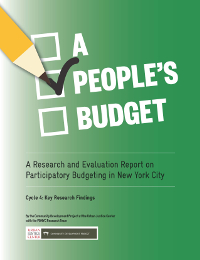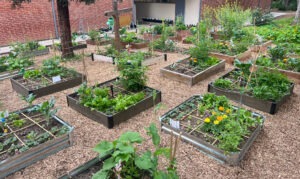The Community Development Project of the Urban Justice Center have been the lead evaluators of PBNYC since the very first cycle in 2011-2012. Last month they released their evaluation report for the city’s fourth cycle of PB, which was by far the largest PB process seen to date in North America. We caught up with researcher Erin Markman, who is also a member of the North American PB Research Board, to learn more about how CDP has adapted their community-driven research model to the ever-expanding scale of PBNYC.

PBP: Where do you fit in the world of PB research?
Erin: The Community Development Project of the Urban Justice Center has been the research partner for Participatory Budgeting in New York City since the first PB cycle here. I coordinated the city-wide research board for New York City’s PB process during the two most recently completed PB cycles, oversaw citywide research efforts, and was the primary author of our research and evaluation reports for PBNYC Cycle 3 and Cycle 4. I also sit on New York City’s PB steering committee, and I’m a member of the North American PB Research Board.
PBP: Can you describe some of the key findings from your recent report on the fourth cycle of PBNYC?
Erin: Sure! I first want to thank the members of our research board, whose time and effort contributed to this research.
The fourth cycle of PB here in New York City (2014-15) was the largest yet, with more than 50,000 PB voters in 24 participating districts. Through our research, we saw the continuation of some trends we’ve previously identified, such as engagement in PB by people who are not otherwise active in their communities, and by those who are marginalized or disenfranchised from regular political processes. For example, nearly a quarter of PB voters reported that they had a barrier to voting in regular elections, including one in ten who reported they could not vote because they weren’t U.S. citizens.
We also investigated some new questions in Cycle 4. Since the process has grown so dramatically, we were interested in how it was being implemented on the ground. We asked staff at participating City Council offices to report to us on a variety of aspects of PB implementation. Through this reporting we were able to look at a picture of PB in the city, showing us, for example, that about a third of neighborhood assemblies were targeted to particular communities such as youth, seniors and public housing residents, and that most districts partnered with a community-based organization to host an assembly. Through this new research we were also able to identify areas for improvement, such as additional emphasis on training of budget delegate committee facilitators, or the provision of childcare, metrocards, food and interpretation at assemblies and delegate meetings.
Additional findings can be found in our Cycle 4 report.
PBP: What are the biggest challenges you’ve encountered in conducting research on PBNYC, and how have you tried to overcome them?
Erin: I think many of our challenges could be categorized as logistical. The process is large, both in terms of numbers of participants and in geographic spread; meeting locations and vote sites are held in a variety of different spaces (libraries, senior centers, public housing developments and even on the street) and are often scheduled or rescheduled on short notice; the process in many districts engages non-English speakers; and there are many different players involved in implementation. Each of these factors, and more, pose challenges for conducting research. Our research board and the Participatory Budgeting Project have been a big help in overcoming these challenges, both by helping us recruit added capacity and by helping to problem solve logistical challenges. And building strong relationships with the staff at Council offices, the City Council Speaker’s office, the PB steering committee, and community based organizations has been instrumental in enabling our research to have the reach that it does. All of these players help to underscore the importance of research, and in some cases are trained to help conduct it. This provides not only added capacity but also helps to embed research in the PB process.
PBP: What has your research uncovered about ways to improve PB in North America?
Erin: We have comprehensive recommendations in our past reports, some of which may be applicable across contexts, though many are New York-specific. I’d like to emphasize that one way to improve PB is through research itself! We’ve been intentional about bringing key principles from our community-driven research model to the PB context. Our research plans are informed by PB practitioners, community based organizations and others, and our research questions are designed to evaluate the specific goals of the PBNYC rule book and to answer the questions of PB stakeholders. We also have a focus on creating accessible, utilitarian research products and recommendations designed to help practitioners improve PB as it continues to expand. If research is tailored to the local PB context it can be used in a variety of ways: to document strengths of the process and identify challenges, to think through revisions to the PB rulebook, to refine outreach and engagement strategies, and more.
PBP: What do you enjoy most about engaging with PB in your work?
Erin: I’ve enjoyed the opportunity to engage with the wide variety of players in the PBNYC world—from staff and members at community based organizations, to New Yorkers who are casting their first ever vote in a US civic process, to those working in local government who are thinking through how best to engage constituents they might not ordinarily reach. The researcher role provides an opportunity to meet many of these people, and that is always a component of my work that I love.




